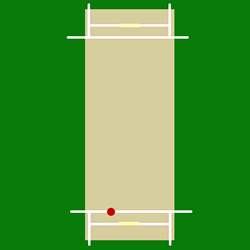Finger spin
| Part of a series on |
| Bowling techniques |
|---|

Finger spin is a style of bowling in the sport of cricket. It refers to the mechanical technique and specific hand movements associated with imparting a particular direction of spin to the cricket ball. The other spinning technique, generally used to spin the ball in the opposite direction, is wrist spin. Although there are exceptions, finger spinners generally turn the ball less than wrist spinners. However, because the technique is simpler and easier to master, finger spinners tend to be more accurate.
Types of finger spinner
Although the biomechanical details of finger spin are the same for right and left-handed bowlers, such bowlers are often discussed separately, as the direction in which the ball deviates as it bounces on the cricket pitch is different:
- Right-handed finger spin is more commonly known as an off spin.
- Left-handed finger spin is more commonly known as a left-arm orthodox spin.
The rest of this article assumes a right handed finger spinner bowling to a right handed batsman.
Grip
A finger spinner grips the ball with the top knuckles of the index and middle fingers firmly gripping across the seam. The thumb is held clear of the ball.
Process
The stock ball for a right handed finger spinner has a clockwise component of spin as well as a component of top spin. The stock ball for a left-handed finger spinner rotates the anticlockwise as seen by the bowler. For some finger spinners the index and middle fingers do a lot of work, snapping, to impart spin on the ball. At the other end of the spectrum there are finger spinners who rely much more on the wrist action. Either way the wrist position at the point of release determines how the ball spins.
| Wrist position | Delivery | Intended outcome |
|---|---|---|
| Palm of hand facing batsman | Traditional off spinner. Side spinner. | Drift away from batsman. Turn from off to leg. |
| Side of hand pointed to leg slip | Stock ball - part top spin, part side spin | Some turn, some dip/bounce and some drift. |
| Side of hand pointed to batsman | Top spinner | Dip - deceptive length. |
| Back of hand facing batsman | Doosra | Turn from leg to off. Deception. |
| Back of hand facing the ground | Under cutter | Drift |
Traditionally, finger spinners bowled with an emphasis on side spin. With the advent of covered and better batting pitches the focus changed to bowling with a component of top spin. The top spin provides loop which makes it harder for the batsman to make an early judgement of the length of the delivery. The ball tends to be released with a slightly upward trajectory which raises the ball above the batsman's eye line. The topspin on the ball then causes the ball to dip earlier and bounce higher.
The side spin component of the delivery causes it to drift, courtesy of Bernoulli's principle. For a stock, side spin or under cutter this causes the ball to drift away from the batsman. The combination of drift, loop and spin combine to provide the finger spinner's chief threats.
Variations
A variation bowled by finger spinners is the arm ball. This is intended to deceive the batsman.
Other coaching points
Other key elements of the process of finger spin are:
- Foot alignment - a line drawn through the back and front feet should line up with where the ball is intended to pitch. Typically the back foot is nearly side on and the front foot between side on and pointing to the target. This aligns the body to deliver the ball to the target.
- Releasing the ball with the weight over the front foot. This drives the bowlers momentum towards the target. It also lets the bowler release the ball from maximum height.
- A vertical shoulder rotation that completes, for a right handed bowler, with the right shoulder pointing at the target.
